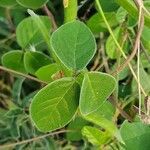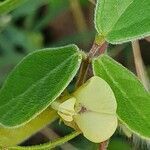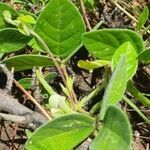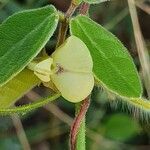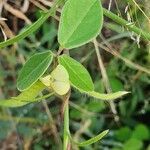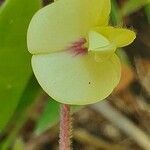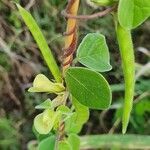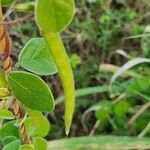Climbing (possibly sometimes suberect) herb up to 60 cm long, from a perennial fibrous rootstock. Stems annual, sparsely to densely spreading or appressed sericeous. Leaves 3-foliolate; leaflets 1-3.5 x 0.7-2.7 cm, ovate-rhombic, obovate or elliptic, rounded or subacute at the apex, rounded at the base, rather thin, laterals oblique, midvein not central, glabrescent to pubescent or rarely velvety on both surfaces; petiole 0.8-6.8 cm long; rhachis 2.5-10 mm long; petiolules 1-2 mm long; stipules 4-8 mm long, lanceolate, striate. Flowers axillary, in pairs or in 3(5)-flowered fascicles, rarely solitary; peduncle and rhachis 0-15 mm long; pedicels 1-7 mm long; bracts 2 mm long, linear; bracteoles 3 mm long, linear, attenuate to an acuminate or filiform apex. Calyx pubescent; tube 3 mm long; lobes 3 mm long, linear, upper pair completely fused. Standard cream, yellow or greenish-yellow, often with a small central purple blotch inside, 6-12 x 4-7 mm, obovate-oblong; wings and keel greenish-yellow, 5-10 mm long. Pods 30-55 x 4-8 mm, linear-oblong, acuminate, densely pilose when young, later more sparsely so, glabrous, smooth or warty along the margins, 7-10-seeded. Seeds pale to dark reddish-brown, speckled and mottled with black and orange-brown or all black, 3-4 x 3-4 x 1.5-2 mm, trapezoidal, oblong or rounded-reniform, margins keeled; hilum and rim aril minute.
Perennial or annual, climbing herbs, to 60 cm tall. Stems clothed with whitish hairs. Stipules lanceolate, 4-8 mm; petiole 0.8-6.8 cm; leaflets 3, thin, ovate-rhomboid, obovate, or elliptic, oblique, 1-8 × 0.7-7.8 cm, glabrous or puberulent or rarely velutinous on both surfaces, base rounded, apex rounded or slightly acute. Flowers (1 or)2 or 3(-5) clustered in axils of leaves; peduncle and rachis of inflorescence 0-1.5 cm; bracts linear, ca. 2 mm. Calyx tube ca. 2 mm; lobes triangular-lanceolate, 3-8 mm. Standard yellow or light yellowish green, with a purple spot in middle, obovate-oblong, 6-12 × 4-7 mm; wings and keel light yellowish green. Legumes linear-oblong, 3-5.5 × 0.4-0.8 cm, puberulent or subglabrous. Seeds light or deep reddish brown, oblong or orbicular-reniform, 3-4.2 × 2.8-3.5 mm.
A climbing or twining herb. The young growth has white hairs. The stems are hairy. The leaves have 3 leaflets. The leaves are 3.5 cm long. The leaflets are 1-2.5 cm long by 0.7-3 cm wide. They are broadly oval. They are thin textured and with a rounded tip. The flowers are about 0.8 cm across. They are greenish-yellow. There are 1-5 flowers in a cluster in the axils of leaves. The fruit is a pod 3-5.5 cm long by 0.4-0.8 cm wide. They are slightly hairy and dark brown when ripe.
Leaves 3-foliolate; leaflets 1–3.5 × 0.7–2.7 cm, ovate-rhombic, obovate or elliptic, rounded or subacute at the apex, rounded at the base, rather thin, laterals oblique, midvein not central, glabrescent to pubescent or rarely velvety on both surfaces; petiole 0.8–6.8 cm long; rhachis 2.5–10 mm long; petiolules 1–2 mm long; stipules 4–8 mm long, lanceolate, striate.
Flowers axillary, in pairs or in 3(5)-flowered fascicles, rarely solitary; peduncle and rhachis 0–15 mm long; pedicels 1–7 mm long; bracts 2 mm long, linear; bracteoles 3 mm long, linear, attenuate to an acuminate or filiform apex.
Seeds pale to dark reddish-brown, speckled and mottled with black and orange-brown or all black, 3–4 × 3–4 × 1.5–2 mm, trapezoidal, oblong or rounded-reniform, margins keeled; hilum and rim aril minute.
Standard cream, yellow or greenish-yellow, often with a small central purple blotch inside, 6–12 × 4–7 mm, obovate-oblong; wings and keel greenish-yellow, 5–10 mm long.
Pods 30–55 × 4–8 mm, linear-oblong, acuminate, densely pilose when young, later more sparsely so, glabrous, smooth or warty along the margins, 7–10-seeded.
Climbing (possibly sometimes suberect) herb up to 60 cm long, from a perennial fibrous rootstock.
Calyx pubescent; tube 3 mm long; lobes 3 mm long, linear, upper pair completely fused.
Stems annual, sparsely to densely spreading or appressed sericeous.
